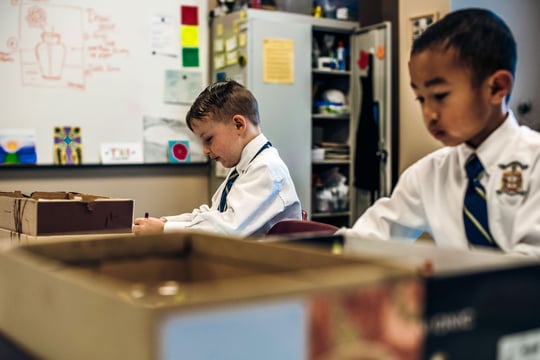 Bible: The students will learn Bible basics – the plan of salvation, the Books of the Bible in order, the major events of biblical history and the theological importance of these events. Our biblical studies teach the following:
Bible: The students will learn Bible basics – the plan of salvation, the Books of the Bible in order, the major events of biblical history and the theological importance of these events. Our biblical studies teach the following:
English: We seek to: (1) equip every student with the skills necessary for good writing, including spelling, grammar, style, clarity, etc.; (2) put a major emphasis on good writing by requiring the students to write often and correctly in each subject area; (3) encourage clear thinking by the students through requiring clear writing; (4) introduce the students to many styles of writing using the Bible and other high quality literature.
History and Geography: We seek to: (1) teach the students that God is in control of History and He will determine its ultimate outcome; (2) enable the students to see God's hand in the history of the world and the United States; (3) broaden the students' understanding of history and geography as the students mature; (4) specifically, begin with local history and geography in first grade and sequentially expand the scope of studies to the world; (5) make history and geography "come alive" for the students through the use of many forms of information and research, e.g. biographies, illustrations, field trips, guest speakers, music, art, foods, and architecture, etc.; (5) give the students a thorough understanding of Western Civilization; its distinctive, great leaders, great movements, and great thinkers; and also its particular involvement in the growth of Christianity.
Mathematics: We seek to: (1) ensure that the students have a thorough mastery of basic mathematical functions and tables; (2) put an emphasis on conceptual, as well as practical understanding of Mathematics through the frequent use of story problems; (3) illustrate God's unchanging character through the timeless, logical mathematical systems He gave to man through His gift of reason.
The ideal progression of a student’s Mathematics courses would start with the successful completion of Saxton Math 1 curriculum in Kindergarten, Saxton Math 2 in First Grade, followed by Saxton Math 3 in Second Grade, then progressing through Saxton 5/4 in Third Grade, Saxton 6/5 in Fourth Grade, Saxton 7/6 in Fifth Grade, and Saxton Math 8/7 in Sixth Grade. At the end of First Grade, each student will be evaluated to determine if they should repeat Saxton Math 2 or progress to Saxton Math 3.
All Lower School Mathematics classes and Upper School Mathematics Course Saxton Math 8/7 are scheduled at the same time to enable students to be placed in the match class that best matches their ability without affecting the remainder of their schedule. This enables students to pursue advanced Mathematics courses in high school, as desired.
Reading: We seek to: (1) use phonics as the primary building blocks for teaching students to read; (2) encourage the students to read correctly as soon as possible (normally in Kindergarten or first grade); (3) introduce the students to high quality children’s literature as soon as possible, through our Literature program; (4) carefully monitor the student's reading abilities to ensure that he comprehends adequately, and is reading fluently, both orally and silently, including the proper use of word-attack skills; (5) foster a life-long love of reading and high quality literature, after being taught to recognize the characteristics of such literature.
Art: We seek to: (1) teach all our students the basic fundamentals of drawing to enable them to create adequate renderings; (2) encourage the students to appreciate and imitate the beauty of the creation in their own works; (3) introduce the students to the works of the master artists of Western culture (4) equip the students to knowledgeably use a variety of art media.